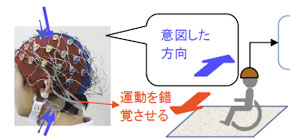
Predicting movement intention from brain waves within 100 ms of stimulation
New technology to decode movement intention using brain’s function to predict consequences of movement
Researchers from the AIST-CNRS* Joint Robotics Laboratory (JRL), Tokyo Institute of Technology, and Osaka University developed a brain computer interface (BCI) method using the brain function of prediction in order to decode movement intentions of humans from their electroencephalography (EEG) at high speed and with a high degree of accuracy.
* AIST -- National Institute of Advanced Industrial Science and Technology; CNRS -- Centre national de la recherche scientifique
Conventional BCI technology decoded users’ movement intentions directly from their brain waves, so user training for enhancing decoding accuracy was required, forcing users to bear a great burden.
It is thought that the brain predicts consequences of movement using an internal forward model and generates motor commands so as to reduce differences between the actual and predicted consequences (prediction errors). Thinking that these prediction errors would have a great influence on brain waves, the researchers developed a new BCI method to use these errors for predicting movement intention.
In experiments, they gave users subliminal sensory stimulation using galvanic vestibular stimulation (GVS) and decoded prediction errors -- whether the sensory prediction corresponding to a user’s intended movement matched the subliminal sensory stimulation induced by the stimulator -- from EEG signals. Specifically, they stimulated the participants’ vestibular system so as to induce a sensation of either turning left or right, albeit subliminally, using GVS and inferred their movement intentions. As a result, it was found that it was possible to decode movement intentions of participants within 100 ms at an accuracy rate of 85% or higher on average.
This method has achieved greater decoding accuracy of movement intention than previous methods without requiring user training or forcing users to bear cognitive load. This technology will help individuals with paralyzed limbs to turn their wheelchairs to the right or left.

Abstract
We propose a new methodology for decoding movement intentions of humans. This methodology is motivated by the well-documented ability of the brain to predict sensory outcomes of self-generated and imagined actions using so-called forward models. We propose to subliminally stimulate the sensory modality corresponding to a user’s intended movement, and decode a user’s movement intention from his electroencephalography (EEG), by decoding for prediction errors—whether the sensory prediction corresponding to a user’s intended movement matches the subliminal sensory stimulation we induce. We tested our proposal in a binary wheelchair turning task in which users thought of turning their wheelchair either left or right. We stimulated their vestibular system subliminally, toward either the left or the right direction, using a galvanic vestibular stimulator and show that the decoding for prediction errors from the EEG can radically improve movement intention decoding performance. We observed an 87.2% median single-trial decoding accuracy across tested participants, with zero user training, within 96 ms of the stimulation, and with no additional cognitive load on the users because the stimulation was subliminal.
Figure 1
Figure 2
The article, "Utilizing sensory prediction errors for movement intention decoding: A new methodology," was published in Science Advances , http://doi.org/10.1126/sciadv.aaq0183 .
Related links

